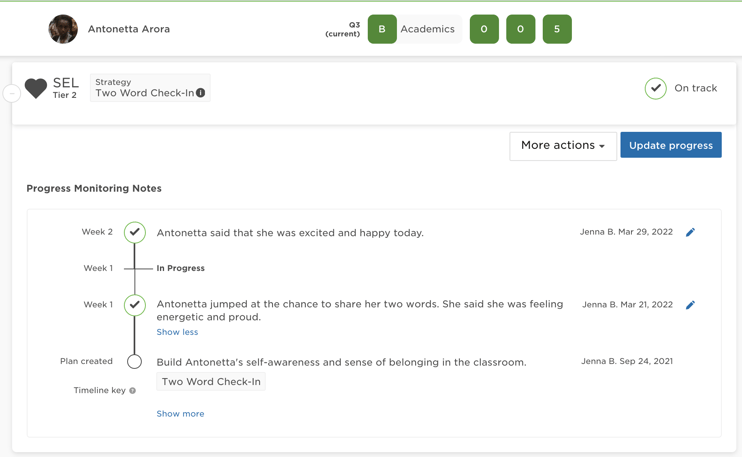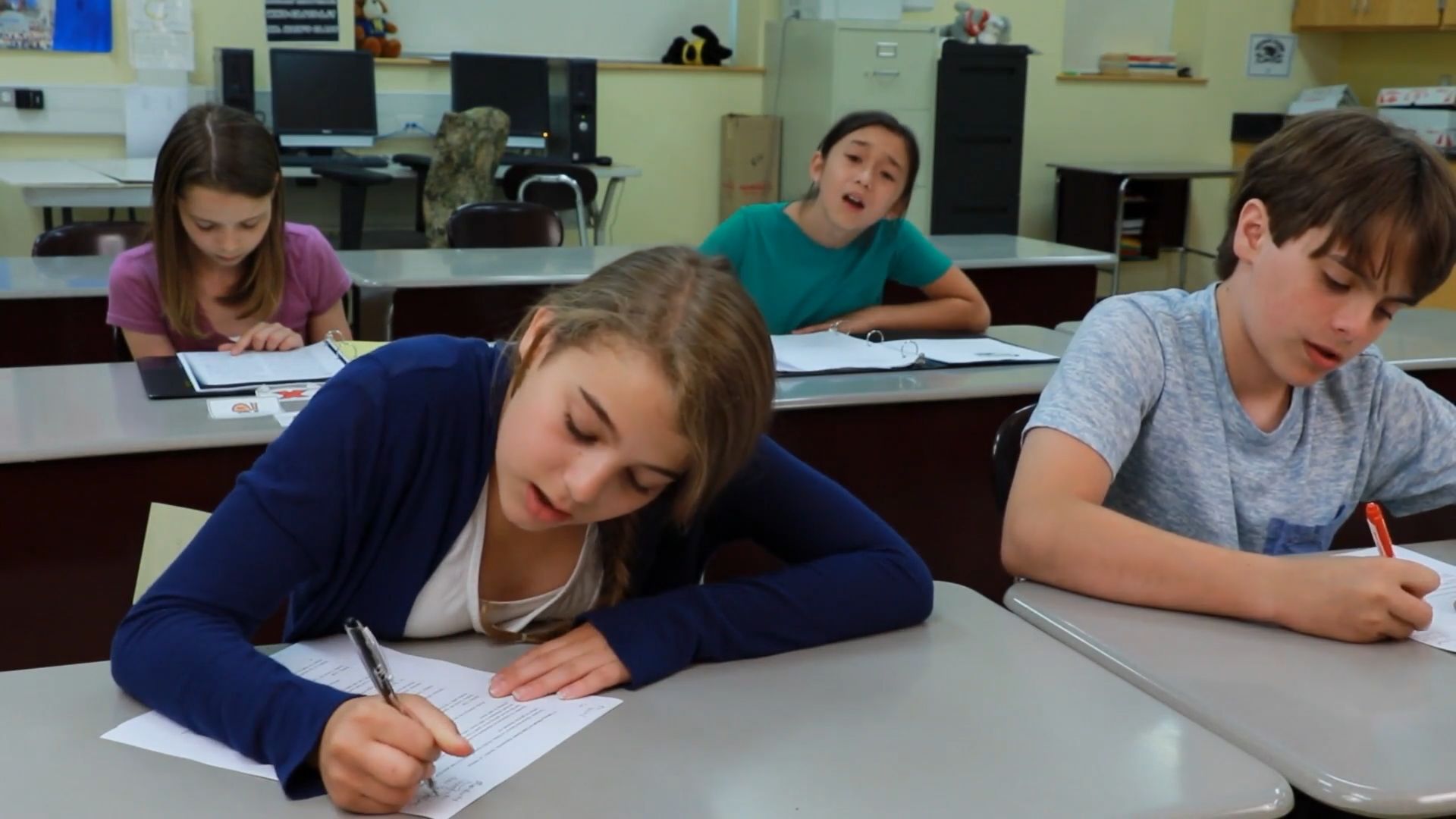In this Panorama Education Intervention Brief, we explore the two-word check-in: a ritual that educators can use to gauge how students (or colleagues) are feeling in the moment. You can find this strategy the intervention library of Student Success, Panorama's MTSS intervention management platform for school districts.
***********************
Quick Summary
Intervention Name: Two-Word Check-In
Tier(s): 1, 2, 3
Grade Levels: K-12
CASEL Competency Alignment: Self Awareness, Social Awareness
Description: The two-word check-in is a simple yet powerful classroom exercise that enhances emotional awareness, promotes authenticity, and builds community.
Check-in with students using these 90 prompts! [Download as a PDF]
Two-Word Check-In Overview
The two-word check-in is a group-oriented and research-backed behavioral intervention. It is often used as an opening or closing ritual to help students (and caring adults) describe how they are feeling. Using the two-word check-in in your school can help to build students’ self awareness and social awareness skills while also increasing their sense of belonging and safety in the classroom.
We start every meeting with a two-word check-in. We take turns sharing two words that describe how we’re feeling that day. We all have the human need to see others and to be seen. The realness connects us.
— Brené Brown (@BreneBrown) December 8, 2020
Today I'm feeling overwhelmed and focused. You? pic.twitter.com/ZMSthssLhx
The two-word check-in gives students an opportunity to reflect on (and label) the emotions that they are experiencing. The goal is to take a pulse on where members of the classroom community are at during the start or the end of a day, class period, or restorative circle. Classroom teachers can implement a two-word check-in in less than 10 to 15 minutes per day and tend to use it with students on a recurring basis.
Adults can also benefit from doing regular feelings check-ins. In many districts, teams of educators will begin meetings with a two-word check-in or an internal weather report. When educators embody the same wellness practices that they hope to teach their students, the outcomes for learners and teachers are amplified.
How to Implement the Two-Word Check-In
- Invite students to find a comfortable seat, either at their desk, on the floor, or together in a circle (if space allows). Make sure your own body language is relaxed and inviting.
- Put both hands over your heart and take a few deep breaths. Ask students to do the same. Invite them to keep a soft gaze or close their eyes, whichever feels more comfortable and safe.
- As you continue to breathe together, ask students to notice how they are feeling. Remind them that all emotions are welcome. Invite them to take a few moments to connect with their feelings and choose two words to describe them.
- When the students have two words in mind, invite them to softly open their eyes and return their focus to the classroom.
- Educators can start by sharing their two-word check-in. Students can take turns sharing their two words, or may pass if they are not comfortable.
If you use Panorama: You can select the "Two Word Check-in" strategy when creating an intervention plan for a student. Monitor the student's progress over time by logging notes. Everything will be saved to the student's profile and visible to other educators with access to Panorama.
 Example of a student intervention plan in Panorama (mock data pictured)
Example of a student intervention plan in Panorama (mock data pictured)
Tips for Effective Implementation
Differentiate the activity by grade level
For students in grades PreK-1: Consider brainstorming a list of feelings as a class. You can draw and label various facial expressions on the board or on a poster. Encourage students to pick words that they helped brainstorm or to draw a “feeling face” before sharing aloud.
For students in grades 2-5: Since elementary students are starting to build a more sophisticated emotional vocabulary, you can provide them with more complex examples of feelings. For example, you might share a feelings wheel.
For secondary students: Consider spending time on reflection questions after they’ve shared their two-word check-in. Do they feel safe enough to share their authentic emotions? How do they think the exercise impacts the classroom community?
Try implementing it in a one-on-one setting
While typically used as an opening or closing ritual with a classroom or small group of students, the two-word check-in can also work in a one-on-one conversation with a student. When a caring adult models the practice of labeling their emotions, it can help to increase their relationship and level of connectedness with a student.
If students are participating in hybrid or remote learning, implement well-being check-ins virtually
Students can use the chat on Zoom or Google Hangouts to share two words that describe how they are feeling. Or, they can un-mute themselves to respond to reflection questions or talk about what's going on in their day.
For team meetings or professional development workshops, consider using the two-word check-in as an icebreaker or opening exercise
The act of checking in can help build educator capacity to model self awareness and self-management.
Carve out additional time for students to reflect on the exercise in groups
Prompt students to explore how it felt to label their feelings, what it was like to describe their emotional state in two words (or one word), and how it felt to hear everyone else share their two-word check in. With middle school and high school students, consider reflection questions such as:
-
- What was it like to give yourself permission to be exactly as you are?
- How did it feel to acknowledge your feelings?
- What was it like to choose two words to describe how you are feeling?
- What was it like to hear everyone else share their two words?
- How do you think this impacted our classroom community?
Additional Resources
- 2x10 Relationship Building: How to Do it (and Why It Works!)
- 101 Inclusive Get-to-Know-You Questions for Students
- Check-In/Check-Out (CICO): Intervention Tips and Guidance
- How Brené Brown Runs Emotionally Intelligent Zoom Meetings
- "Rose, Bud, Thorn" Activity and Worksheet for School-wide Implementation
- Two Word Check In Worksheet (Primary)
- Two Word Check In Worksheet (Secondary)
Download our Student Check-ins Question Bank (includes 80 questions!)







.webp?width=480&height=597&name=checkins-question-bank-book%20(1).webp)